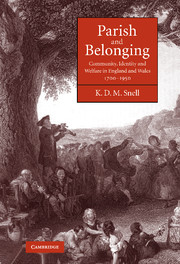Book contents
- Frontmatter
- Contents
- List of figures
- List of tables
- Preface and acknowledgements
- 1 Introduction – belonging and local attachment
- 2 The culture of local xenophobia
- 3 Settlement, parochial belonging and entitlement
- 4 Rural societies and their marriage patterns
- 5 ‘A cruel kindness’: parish out-door relief and the new poor law
- 6 Nailed to the church door? Parish overseers and the new poor law
- 7 Three centuries of new parishes
- 8 ‘Of this parish’: gravestones, belonging and local attachment
- 9 Conclusion – belonging, parish and community
- Select bibliography
- Subject and persons index
- Places index
7 - Three centuries of new parishes
Published online by Cambridge University Press: 27 July 2009
- Frontmatter
- Contents
- List of figures
- List of tables
- Preface and acknowledgements
- 1 Introduction – belonging and local attachment
- 2 The culture of local xenophobia
- 3 Settlement, parochial belonging and entitlement
- 4 Rural societies and their marriage patterns
- 5 ‘A cruel kindness’: parish out-door relief and the new poor law
- 6 Nailed to the church door? Parish overseers and the new poor law
- 7 Three centuries of new parishes
- 8 ‘Of this parish’: gravestones, belonging and local attachment
- 9 Conclusion – belonging, parish and community
- Select bibliography
- Subject and persons index
- Places index
Summary
Looking back … upon England, as it was before the Reformation, we find that … the religion of the country, by means of its forms and ceremonies, was interwoven with the whole business of life … The diseased growth of parishes frustrated the political as well as the religious purposes of our old parochial system, if we may be permitted to consider apart things which are, strictly speaking, inseparable.
Of late years, an abundant shower of curates has fallen upon the north of England.
The parochial system is, no doubt, a beautiful thing in theory, and is of great value in small rural districts; but in the large town it is a mere shadow and a name.
INTRODUCTION
The 1911 national census highlighted a remarkable fact. By that date about 8,322 parishes in England and Wales (58 per cent of the total) were not coterminous for civil and ecclesiastical purposes. This phenomenon, which the census report emphasised as a matter of great concern, also raised apprehensions in earlier censuses. It stood in contrast to the situation in the late eighteenth century or earlier, when the very large majority of parishes had been co-extensive for civil and ecclesiastical matters. At that earlier time, as throughout the medieval and early modern period, civil and religious affairs had been closely bonded together in parish life. Yet this was far less the case by 1911.
- Type
- Chapter
- Information
- Parish and BelongingCommunity, Identity and Welfare in England and Wales, 1700–1950, pp. 366 - 453Publisher: Cambridge University PressPrint publication year: 2006
- 2
- Cited by



